

Aspen Ideas Festival: Being Latino in America today
There are 55 million Hispanics in the United States, and demographers expect Latinos will account for half of America’s population growth, and a substantial amount of economic growth as well.
Former San Antonio Mayor Henry Cisneros says Latinos are the biggest story in the whole multicultural evolution of the United States — despite their exclusion from most history books, which tend to look only at white and black issues.
“Over the last 50 years we have made immense progress,” Cisneros said during a panel discussion at the Aspen Ideas Festival, June 29, 2017. “(People) understand our economic contribution, that mainstream economics idea. This country’s future workforce, its health of its social security system, its entrepreneurial new business formations is all about the role Latinos are going to play.”…
Link to article
Mexican migrant workers came to California to pick grapes. Now they own wineries.
The Smithsonian recognizes five families who have worked their way up in the U.S. wine industry
Outside Robledo Family Winery, south of Sonoma, on a cool April Sunday, the U.S. and Mexican flags whipped a stiff salute in the wind blowing off the San Pablo Bay. A third banner bore the winery logo. The flags represent three themes central to the lives of Reynaldo Robledo and many other Mexican migrant workers who have helped shape California’s wine industry: heritage, opportunity and family…
Link to article
Analyst: Latino grocery stores likely to see more deals
Scott Moses, managing director and head of food retail and restaurants investment banking for Peter J. Solomon Co., said he sees a rise in Latino-focused grocers in the future, according to the Shelby Report.
Private equity firm KKR recently invested in Cardenas Markets (currently operating 30 stores) and Mi Pueblo (operating 19 stores).
Latino Americans comprise approximately 17% of the U.S. population in 2017….
Link to article
Managing Diversity in Organizations: A Global Perspective
M Triana – 2017 – books.google.com
This book equips students with a thorough understanding of the advantages and challenges
presented by workplace diversity, suggesting techniques to manage diversity effectively and
maximize its benefits. Readers will learn to work with diverse groups to create a productive..
Link to book preview
Hispanic Homeownership Rate Continues to Rise
The Hispanic homeownership rate rose from 45.6 percent in 2015 to 46 percent in 2016, according to data from the National Association of Hispanic Real Estate Professionals (NAHREP). This is the second year in a row that this demographic experienced a homeownership rate increase.
This increase in homeownership is mirrored by a decline in the overall U.S. homeownership rate—a slight dip from 63.7 percent in 2015 to 63.4 percent last year—and reported declines in homeownership among African-Americans and Asian-Americans. NAHREP also reported that Hispanics led in net household formations in 2016, adding a total net increase of 330,000 households…
Link to article
Trump puts U.S. food, farm companies on edge over Mexico trade
By Tom Polansek and Mark Weinraub | CHICAGO
U.S. food producers and shippers are trying to speed up exports to Mexico and line up alternative markets as concerns rise that this lucrative business could be at risk if clashes over trade and immigration between the Trump administration and Mexico City escalate.
Diplomatic relations have soured fast this month, as the new U.S. administration floated a 20 percent tax on Mexican imports and a meeting between the presidents of the two countries was canceled. U.S. President Donald Trump has also pledged to renegotiate the North American Free Trade Agreement (NAFTA) trade deal with Mexico and Canada…
Link to article
Mexico President: NAFTA Benefits Both Sides of the Border
LIMA, Peru – Several U.S. allies expressed worry over what changes could take place when it comes to trade under president-elect Donald Trump’s administration at a summit of Asian-Pacific leaders in Peru on Saturday.
Mexican President Enrique Peña Nieto said NAFTA benefits workers and companies on both sides of the border. He expressed concern that the U.S. could be turning its back on a bilateral trade relationship responsible for moving $1 million worth of goods every minute…
Link to article
Mexican American Proarchive: Annual Report on Mexican American Professionals
News from the census American Community Survey is generally good for the 2015 year. Mexican American college enrollment was up from 18.7% to 18.9% in the 2014 and 2015 years. Graduate or professional degree attainment was also up from 2.9% to 3.0%. The number of bachelor’s degrees granted to Mexican American students rose from 7.6% in 2014 to 7.8% in 2015.


In spite of these gains, Mexican Americans still remain at the bottom of the ladder when it comes to earning a bachelor’s degree. Even after broadening the group to Latinos or Hispanics, this group still lags behind. According to the Pew Hispanic Center: “As of 2014, among Hispanics ages 25 to 29, just 15% of Hispanics have a bachelor’s degree or higher. By comparison, among the same age group, about 41% of whites have a bachelor’s degree or higher (as do 22% of blacks and 63% of Asians).” Pew reports that the main reasons for this low graduation rate is that Hispanics are less likely “to enroll in a four-year college, attend an academically selective college and enroll full-time.”
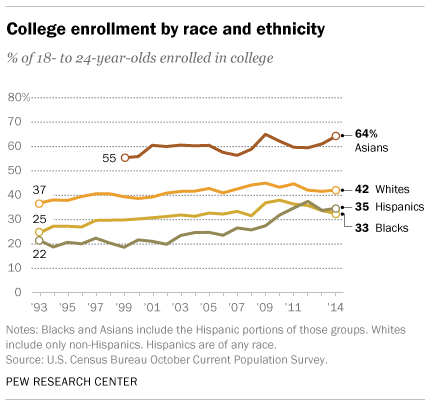
Also in the good news column, the University of California will continue to push for a greater number of underrepresented minorities; namely, Chicano/Latino students whose resident freshmen numbers rose from 2.7% to 32.3% of admitted California freshmen. In other good news, the proportion of Chicano/Latino students transferring from community colleges increased to 29.3% from 26.8% for 2015.
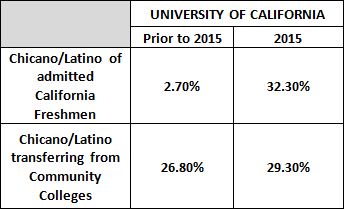
Occupations, including those in management, business, science, and art, fared better for Mexican Americans. The number of Mexican Americans filling these occupations rose from 17.4% in 2014 to 17.5% in 2015.

The total number of Hispanics filling these occupations was 16.1% in 2015, a bit lower than Mexican Americans specifically.
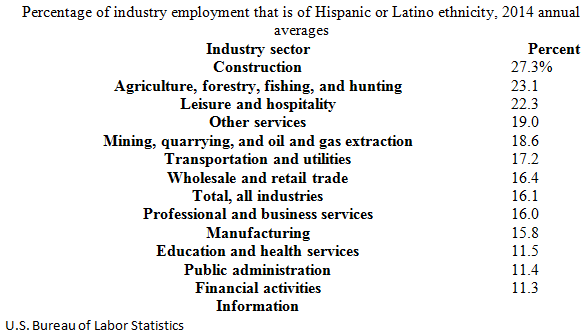
The report shows that industrial employment for Mexican Americans remained the same for 2014 and 2015 at 10.2%.
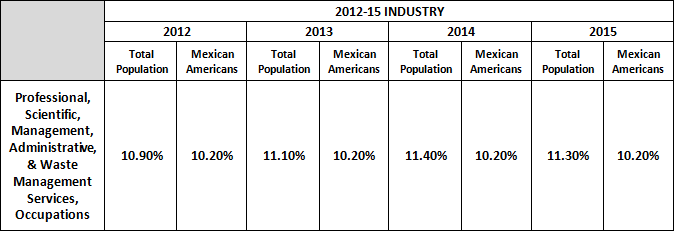
The figures for Hispanic or Latino employment for 2015 and 2016 show a healthy increase.
According to the Pew Hispanic center, “Construction, professional and business services, health services, financial services and food services…showed healthy gains.” Most of the jobs gained by native-born Hispanic workers were in manufacturing, mostly durable goods (82,000 Hispanic workers in this industry), followed by wholesale and retail trade (79,000), publishing, broadcasting, communication and information services (55,000), and construction (54,000).
Foreign-born Hispanics had the most job gains in construction (417,000), followed by business and professional services (179,000). Together, those two industries accounted for almost three-quarters (74%) of all jobs gained by foreign-born Latinos between 2005 and 2006.
The business and professional services sector, which ranges from management and technical services to janitorial, landscaping, and waste management services, is also a key employer for non-Hispanic workers. Of the total increase in employment in 2005-06, non-Hispanic workers accounted for 410,000 employees in the industry, native-born workers 327,000, and foreign-born workers 83,000.
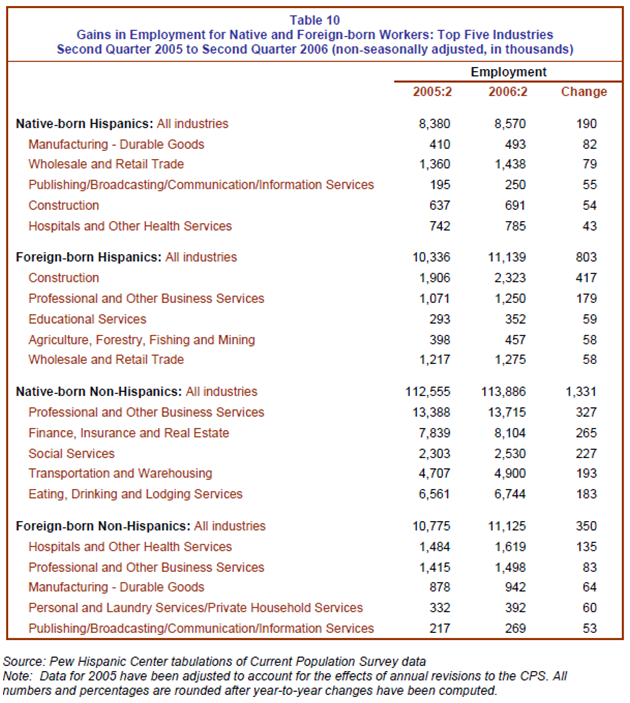
Sources
- Census Bureau, Selected Population Profile in the United States: 2015
- Pew Research Center
- University of California
- Bureau of Labor Statistics
Statistical Portrait of Hispanics in the United States
There were 55.3 million Hispanics in the United States in 2014, comprising 17.3% of the total U.S. population. In 1980, with a population of 14.8 million, Hispanics made up just 6.5% of the total U.S. population. Read the accompanying report, “The Nation’s Latino Population Is Defined by Its Youth.”…
Link to article
Without Change, African-American and Latino Families Won’t Match Current Average White Wealth for Centuries
WASHINGTON – If current federal wealth-building policies remain in place, it will take the average African-American family 228 years to amass the same amount of wealth that white families have today and it will take Latino families 84 years to reach that goal, according to a new report from the Corporation for Enterprise Development (CFED) and the Institute for Policy Studies (IPS).
The Ever-Growing Gap: Failing to Address the Status Quo Will Drive the Racial Wealth Divide for Centuries to Come shows how the well-documented chasm between white household wealth and African-American and Latino household wealth will play out over a period of decades and even centuries if nothing is done to change the current scenario.
For instance, the report finds that by 2043, when households of color are projected to account for more than half the U.S. population, the racial wealth divide between white households and African- American and Latino households will have doubled from about $500,000 in 2013 to $1 million…
Link to article
Jobs Report: Latino Unemployment Rate Falls in July
July surpassed expectations for job growth in the U.S., and although the national unemployment rate stayed the same, the Latino labor force saw gains in job growth.
More than 255,000 jobs were added in July, which surpassed predictions of about 180,000 for the same month. The Latino unemployment rate fell from 5.8 percent to 5.4 percent, according to the National Council of La Raza’s jobs report.
The national unemployment rate stayed constant at 4.9 percent, the U.S. Department of Labor reported.
The number of employed Latino workers increased from 25.1 million in June, to 25.3 million. In July. Meanwhile, the number of Latinos available for work or not working dropped by about 100,000.
NCLR speculated Latino workers benefited from the addition of 45,000 hospitality jobs in July…
Link to article
Hispanic millennials make less, but save more
Most millennials are trying to save for retirement, but female and Hispanic millennials make less money than their counterparts and are more focused on everyday finances, according to new survey results released Wednesday by Wells Fargo.
The survey focused on how millennials plan for retirement. A $1-million savings goal is supposed to provide enough retirement funds for decades, according to Wells Fargo. While 64 percent of respondents said they don’t think they will ever save enough to hit that mark, nearly 60 percent have started stashing away money anyway…
Link to article
Hispanics In The Boardroom: Glass Ceiling Or Foggy Windshield?
We all know about glass ceilings as the deceiving transparency of moving into the upper ranks of a corporation by members of under-represented groups. We don’t often think of that barrier as a detriment to an enterprise’s long-term success and value. We tend to think of it as a matter of fairness and equity towards those who have struggled to gain access and develop their careers.
However, if one stops to think a bit more deeply, glass ceilings inhibit vision and action that could augment the ability of a company to see more opportunities, understand more consumers and manage resources more effectively. By blocking would be points of view that could contribute valuable insights to corporate strategy, glass ceilings are actually obstacles to rapid evolution, which could stunt the growth of companies seeking a fresh outlook on rapidly growing consumer segments — such as women, cultural minorities and those with unconventional gender identification…
Link to article
A Latino Angel Wants To Help You Invest In Tech Startups
For the past two decades, I have been an advisor to many technology startups, and I can tell you this: raising the first million is the hardest.
Even harder: raising the first million if you are Latino/Latina founder.
Last week, DreamFunded – a San Francisco-based company that I’ve written about before — became the first SF-headquartered firm to get approval from FINRA to launch a portal that will enable many people — not just the rich — to invest in technology through crowdfunding. According to DreamFunded, it’s also the first Latino-led equity crowdfunding portal anywhere to get FINRA approval…
Link to article
Hispanic Home Ownership and Wealth in Perspective
As it turns out, last year’s encouraging trend among Hispanic homeowners belies a widening gap in wealth between Hispanics and whites, according to a new report by Hispanic Wealth Project (HWP) that looks at the past few years.
While in 2015, Hispanics drove homeownership growth for the U.S.‒‒accounting for 69 percent of the total net growth in U.S. homeownership‒‒ the fact remains that homeownership is still only about 45 percent for Hispanics in the U.S.. In fact, the median Hispanic household is still a renter household, according to the report…
Link to article
For Bilingual Hispanic Families, New College Search Tools Shine A Light On Financial Aid
Now in Spanish, the “Kayak.com” of financial aid enables seamless comparison of personalized tuition estimates, Obama College Scorecard Data across 5,600 U.S. colleges and universities.
Launched at the 2016 Clinton Global Initiative America meeting, free online tools College Ábaco and Pell Ábaco address key hurdles to Hispanic college enrollment: language barriers and cost perceptions..
Link to article
Is Acculturation Really Dead?
We’ve been hearing the death knell for acculturation for the past several years now in the Hispanic marketing world. A large percentage of Fortune 1000 companies, however, still use acculturation as a point of reference for segmentation so as a research company we still see acculturation models regularly.However, a call with an ad agency last week made us do a double take and question, is acculturation really dead? We were discussing a research strategy and mentioned segmenting by acculturation for research purposes and we were stopped dead in our tracks by the statement, “Let me stop you there. All Hispanics are bicultural. All Hispanics speak English. Acculturation is an outdated concept.” …
Link to article
NALEO Educational Fund Board Member Rick Olivarez Joins Master Your Card Latino Advisory Board Read more: http://www.benzinga.com/pressreleases/16/05/p8052813/naleo-educational-fund-board-member-rick-olivarez-joins-master card Latino Advisory Council
Olivarez to work with Master Your Card: Oportunidad to help Latinos realize greater financial inclusion and growth
WASHINGTON, D.C. (PRWEB) May 31, 2016
Master Your Card: Oportunidad, a community empowerment program sponsored by MasterCard®, today announced that Rick Olivarez, National Association of Latino Elected and Appointed Officials (NALEO) Educational Fund board member, joined the program’s advisory board.
“Rick Olivarez and generations of his family, including his grandfather who founded NALEO, have been committed to advancing the Latino community,” said Fabián Nuñez, former speaker of the California Assembly and chair of the Master Your Card: Oportunidad Advisory Board. “The Board consists of nationally recognized Latino leaders who…
Link to article
The Growing Economic power of Latino-Americans-by the numbers
While much of the rhetoric regarding Latinos this election cycle has focused on the divisive issue of immigration, a bipartisan group is out to change the narrative. The Latino Donor Collaborative aims to emphasize the growing economic power of Latino-Americans, and the potent political force they can become. John Yang talks to co-founders Henry Cisneros and Sal Trujillo for more…
Link to interview
Why is There No Room for Hispanics On Corporate Boards?
For the seventh consecutive year, the percent of directors of Hispanic origin elected to Fortune 500 boards was sharply lower than the overall representation of Hispanics in the U.S. population, according to the Heidrick & Struggles 2016 board monitor.
Of 399 new directors appointed by Fortune 500 companies in 2015, only 16 were Hispanic — a measly four percent. Over the past seven years, an average of 4.7 percent of new directors have been Hispanic. That dire statistic reveals there has been no discernible upward trend. Nothing. As the Hispanic share of the U.S. population has grown during those years, the gap of under-representation in the boardroom has therefore widened…
Link to article


